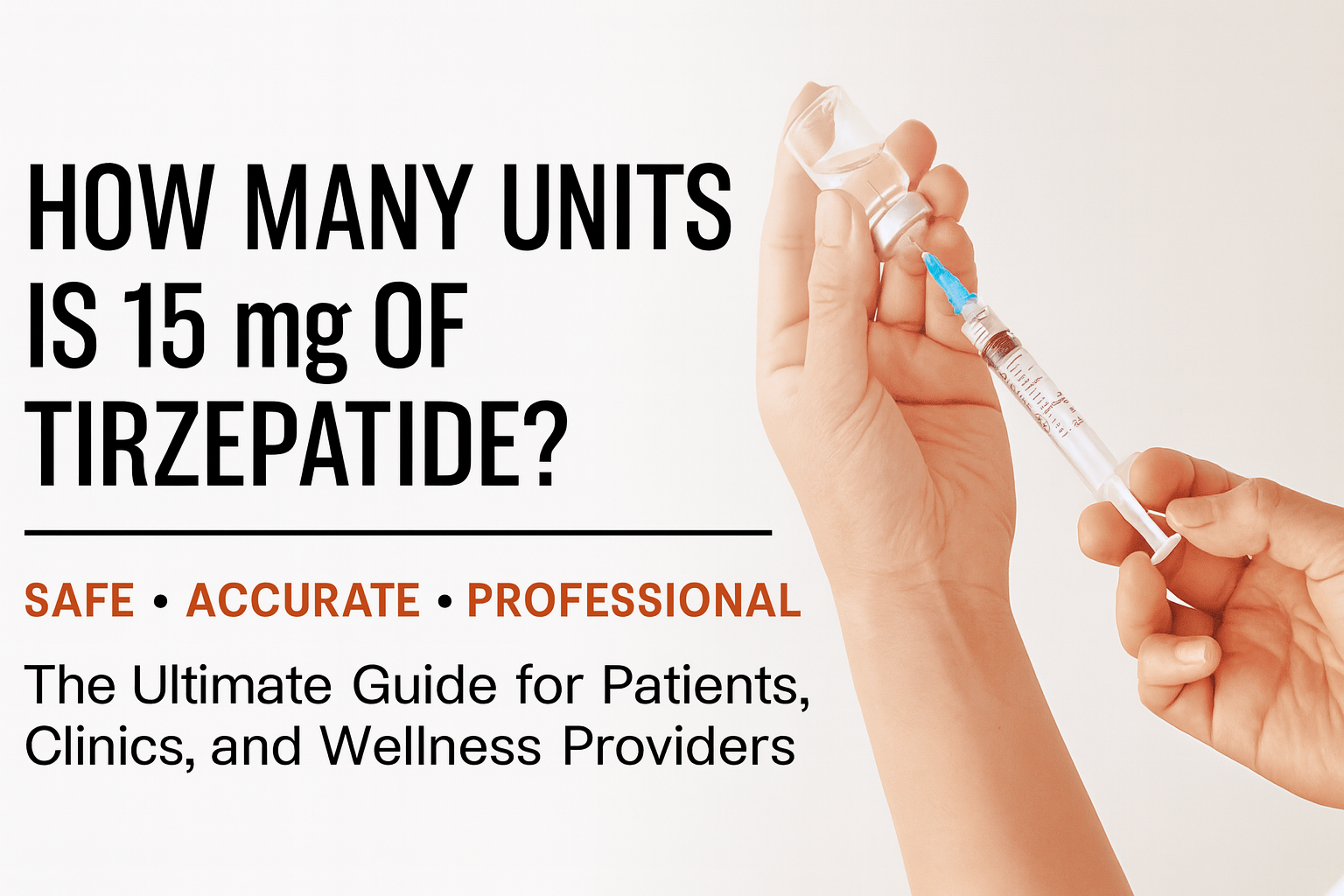A Complete Dosage Conversion Guide
Tirzepatide has become one of the most widely used medications for weight management and blood-glucose control. Patients who use compounded tirzepatide or reconstituted vials often face a practical question:
How many units is 15 mg of tirzepatide?
To answer this correctly, we need to understand how tirzepatide concentrations work, how insulin syringes measure units, and what conversion applies depending on your vial strength.
Why Tirzepatide Uses mg, but Patients Use Units
Commercial pens dose tirzepatide directly in milligrams (mg).
However, compounded tirzepatide or reconstituted vials are usually drawn using:
-
Insulin syringes (100 units = 1 mL)
-
Solutions measured in milligrams per milliliter (mg/mL)
So, the only way to convert mg → units is to know the concentration of your tirzepatide vial.
Standard Concentration Used for Conversion
Most common compounded tirzepatide concentrations include:
| Formulation | Concentration | Notes |
|---|---|---|
| 5 mg / mL | Most widely used | Matches examples in many dosing guides |
| 10 mg / mL | Higher concentration | Requires smaller injection volumes |
| 2.5 mg / mL | Lower concentration | Sometimes used for beginners |
The article you referenced uses the 5 mg/mL formula — so we will use that as the primary conversion.
How Many Units Is 15 mg of Tirzepatide at 5 mg/mL?
Step 1 — Convert mg to mL
15 mg ÷ 5 mg/mL = 3.0 mL
Step 2 — Convert mL to units
1 mL = 100 units
3.0 mL × 100 = 300 units
✅ 15 mg of tirzepatide = 300 units (5 mg/mL concentration)
Conversion Table for 15 mg at Different Concentrations
If your vial uses a different concentration, refer to this chart:
| Concentration | Formula | Units for 15 mg |
|---|---|---|
| 5 mg/mL | 15 ÷ 5 × 100 | 300 units |
| 10 mg/mL | 15 ÷ 10 × 100 | 150 units |
| 2.5 mg/mL | 15 ÷ 2.5 × 100 | 600 units |
This shows how dramatically dosing volume changes based on formulation strength.
Why Concentration Matters So Much
Misunderstanding your vial strength can lead to:
-
Underdosing (no effect or slow weight loss)
-
Overdosing (severe nausea, vomiting, appetite suppression, dehydration)
Never assume your vial is 5 mg/mL unless clearly labeled.
How to Find Your Correct Concentration
Check:
-
The vial label
-
Pharmacy documentation
-
Your prescription sheet
-
Reconstitution instructions (if powder)
If it says something like:
-
“15 mg/3 mL” → 5 mg/mL
-
“20 mg/2 mL” → 10 mg/mL
-
“5 mg/2 mL” → 2.5 mg/mL
—then you can use the correct formula from the table above.
How to Convert Any Tirzepatide Dose (General Formula)
If you ever need to calculate any dose:
Units = (mg dose ÷ mg/mL concentration) × 100
Examples:
-
5 mg at 5 mg/mL → (5 ÷ 5) × 100 = 100 units
-
10 mg at 10 mg/mL → (10 ÷ 10) × 100 = 100 units
-
7.5 mg at 5 mg/mL → (7.5 ÷ 5) × 100 = 150 units
Important Safety Notes
-
Always confirm concentration before injecting.
-
Use insulin syringes (100 units = 1 mL) for accurate measurement.
-
Rotate injection sites to avoid irritation.
-
Never mix tirzepatide with other medications in the syringe.
-
This guide supports understanding — always follow professional medical instructions.
Summary
| Dose | Concentration | Units |
|---|---|---|
| 15 mg tirzepatide | 5 mg/mL | 300 units |
To put it simply:
At the standard 5 mg/mL concentration, 15 mg = 300 units.
But if your pharmacy uses a different strength, the number of units changes — always check before injecting.·
Post time: Nov-19-2025


